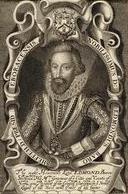Loading AI tools
British peer and Member of Parliament From Wikipedia, the free encyclopedia
Captain Edmund Sheffield, 1st Earl of Mulgrave, 3rd Baron Sheffield, KG (7 December 1565 – 6 October 1646) was a British peer and member of parliament, who served as Lord Lieutenant of Yorkshire from 1603 to 1619 and Vice-Admiral of Yorkshire from 1604 to 1646. He was created Earl of Mulgrave in 1626.
Edmund Sheffield, 1st Earl of Mulgrave | |
|---|---|
 | |
| 1st Earl of Mulgrave | |
| In office 5 February 1926 – 6 October 1646 | |
| 3rd Baron Sheffield | |
| In office 10 December 1568 – 6 October 1646 | |
| Vice-Admiral of Yorkshire | |
| In office 1604 – 6 October 1646 | |
| President of the North | |
| In office 19 September 1603 – 1619 | |
| Lord Lieutenant of Yorkshire | |
| In office 1 August 1603 – 1619 | |
| Governor of Brill | |
| In office 1598–1599 | |
| Personal details | |
| Born | December 7, 1565 Oxford |
| Died | October 6, 1646 (aged 80) Butterwick House, Hammersmith |
| Resting place | St Paul's Church, Hammersmith |
| Spouses |
|
| Relations |
|
| Children |
|
| Parents | |
| Education | Christ Church, Oxford |
| Alma mater | University of Oxford |
| Occupation | Politician |
Edmund Sheffield was born on 7 December 1565 to John Sheffield, 2nd Baron Sheffield and Douglas Howard, daughter of William Howard, 1st Baron Howard of Effingham.[1]
Sheffield's grandfather, Sir Edmund Sheffield, a second cousin of Henry VIII, was raised to the Peerage in 1547 as Baron Sheffield of Butterwick, and was murdered in the streets of Norwich during Kett's Rebellion in 1549.[2]
Sheffield was educated at Christ Church, Oxford from 1574 to 1579.[3]

In 1582, Sheffield was commanded by Queen Elizabeth I to accompany the Duke of Anjou on his return voyage to the European mainland. Sheffield later served as a volunteer in the Netherlands in 1585.[3]
Sheffield served under the command of his maternal uncle, Charles Howard, 2nd Baron Howard of Effingham, against the Spanish Armada in 1588, captaining the "Victory", "Dreadnought and "White Bear" (also known as the "White Rose").[4] On 25 July 1588, Sheffield was knighted by for valiant services in the Anglo-Spanish War (1585–1604).[5]
For his services, Queen Elizabeth I granted Sheffield in 1591 the Manor of Mulgrave in Yorkshire, part of the forfeited estate of Sir Francis Bigod.[6] On 21 April 1593, Sheffield was made a Knight of the Most Noble Order of the Garter by Queen Elizabeth I.[6] Sheffield later served in the Nine Years' War.[5]
On 13 January 1598, Sheffield was appointed Governor of Brill, Holland.
Sheffield requested appointment to the presidency of the Council of the North under Queen Elizabeth I but was unsuccessful.[4] Under King James I, Sheffield was made Lord Lieutenant of Yorkshire on 1 August 1603 and President of the North on 19 September 1603.[5][6] Sheffield held both posts until 1619 when he resigned to please the Spanish ambassador, having executed a Catholic priest without the leave of King James I.[6]
Sheffield took an active interest in the colonialisation of the United States, causing him financial difficulty.[7] Sheffield joined the Virginia Company on 23 May 1609 and the New England Company on 3 November 1620.[6] On 1 June 1621, he was one of the signatories to the first Plymouth patent.[6]
Sheffield was made 1st Earl of Mulgrave on 5 February 1626 following the coronation of Charles I of England. However, he took the side of the Parliament in the English Civil War as one of the twelve peers who signed the petition of 28 August 1640.[6]
Due to his age, Sheffield was not able to attend the House of Lords consistently, however his proxy vote allowed his grandson Sir Thomas Fairfax to be commissioned Captain-General of the New Model Army in 1645.[8]
Sheffield married Ursula Tyrwhitt before 13 November 1581, daughter of Sir Robert Tyrwhite of Kettleby and Elizabeth Oxenbridge. They had six sons and eleven daughters:
Ursula died in 1619. Due to financial difficulties, Sheffield set out to marry a rich wife.[4]
On 4 March 1619, Sheffield married Mariana Irwin (or Irvine), the 16 year old daughter of his dancing master Sir William Irvine (or Urwin), a Scottish courtier who was a Gentleman Usher to Prince Henry and Charles I of England.[9][4] They had three sons and two daughters:
Sheffield died on 6 October 1646 at Butterwick House in Hammersmith.[1] He was buried in St Pauls, Hammersmith in a tomb of black and white marble 7 feet (2.1 m) long, 3 feet (0.91 m) high and 3 feet (0.91 m) over, defended with iron rails, where a monument to his memory was erected by his wife Mariana, Countess of Mulgrave.[5]
Sheffield was succeeded by his grandson, Edmund Sheffield, 2nd Earl of Mulgrave, son of Sir John Sheffield.
Sheffield's Garter stall plate is visible in St. George’s Chapel at Windsor Castle.[4]
| Ancestors of Edmund Sheffield, 1st Earl of Mulgrave | ||||||||||||||||||||||||||||||||||||||||||||||||||||||||||||||||||||||||||||||||||||||||||||||||||||||||||||||||||||||||||||||||||||||||||||||||||||||||||||||||||||||||||||||||||||||||||||||||||||||||||||||||||||||||||||||||||||||||||||||||||||||||||||||||||||||||||||||||||||||||||||||||||||||||||||||||||||||||||||||||||||||||||||||||||||||||||||||||||||||||||||||||||||||||||||||||||||||||||||||||||||||||||||||||||||||||||||||||||||||||||||||||||||||||||||||||||||||||||||||||||||||||||||||||||||||||||||||||||||||||||||||||||||||||||||||||||||||||||||||||||||||||||||||||||||||||||||||||
|---|---|---|---|---|---|---|---|---|---|---|---|---|---|---|---|---|---|---|---|---|---|---|---|---|---|---|---|---|---|---|---|---|---|---|---|---|---|---|---|---|---|---|---|---|---|---|---|---|---|---|---|---|---|---|---|---|---|---|---|---|---|---|---|---|---|---|---|---|---|---|---|---|---|---|---|---|---|---|---|---|---|---|---|---|---|---|---|---|---|---|---|---|---|---|---|---|---|---|---|---|---|---|---|---|---|---|---|---|---|---|---|---|---|---|---|---|---|---|---|---|---|---|---|---|---|---|---|---|---|---|---|---|---|---|---|---|---|---|---|---|---|---|---|---|---|---|---|---|---|---|---|---|---|---|---|---|---|---|---|---|---|---|---|---|---|---|---|---|---|---|---|---|---|---|---|---|---|---|---|---|---|---|---|---|---|---|---|---|---|---|---|---|---|---|---|---|---|---|---|---|---|---|---|---|---|---|---|---|---|---|---|---|---|---|---|---|---|---|---|---|---|---|---|---|---|---|---|---|---|---|---|---|---|---|---|---|---|---|---|---|---|---|---|---|---|---|---|---|---|---|---|---|---|---|---|---|---|---|---|---|---|---|---|---|---|---|---|---|---|---|---|---|---|---|---|---|---|---|---|---|---|---|---|---|---|---|---|---|---|---|---|---|---|---|---|---|---|---|---|---|---|---|---|---|---|---|---|---|---|---|---|---|---|---|---|---|---|---|---|---|---|---|---|---|---|---|---|---|---|---|---|---|---|---|---|---|---|---|---|---|---|---|---|---|---|---|---|---|---|---|---|---|---|---|---|---|---|---|---|---|---|---|---|---|---|---|---|---|---|---|---|---|---|---|---|---|---|---|---|---|---|---|---|---|---|---|---|---|---|---|---|---|---|---|---|---|---|---|---|---|---|---|---|---|---|---|---|---|---|---|---|---|---|---|---|---|---|---|---|---|---|---|---|---|---|---|---|---|---|---|---|---|---|---|---|---|---|---|---|---|---|---|---|---|---|---|---|---|---|---|---|---|---|---|---|---|---|---|---|---|---|---|---|---|---|---|---|---|---|---|---|---|---|---|---|---|---|---|---|---|---|---|---|---|---|---|---|---|---|---|---|---|---|---|---|---|---|---|---|---|---|---|---|---|---|---|---|---|---|---|---|---|---|---|---|---|---|---|---|---|---|---|---|---|---|---|---|---|---|---|---|---|---|---|---|---|---|---|---|---|---|---|---|---|---|---|---|---|---|---|---|---|---|---|---|---|---|---|---|---|---|---|---|---|---|---|---|---|---|---|---|---|---|---|---|---|---|---|---|---|---|---|---|---|---|---|---|---|---|---|---|---|
| ||||||||||||||||||||||||||||||||||||||||||||||||||||||||||||||||||||||||||||||||||||||||||||||||||||||||||||||||||||||||||||||||||||||||||||||||||||||||||||||||||||||||||||||||||||||||||||||||||||||||||||||||||||||||||||||||||||||||||||||||||||||||||||||||||||||||||||||||||||||||||||||||||||||||||||||||||||||||||||||||||||||||||||||||||||||||||||||||||||||||||||||||||||||||||||||||||||||||||||||||||||||||||||||||||||||||||||||||||||||||||||||||||||||||||||||||||||||||||||||||||||||||||||||||||||||||||||||||||||||||||||||||||||||||||||||||||||||||||||||||||||||||||||||||||||||||||||||||
Seamless Wikipedia browsing. On steroids.
Every time you click a link to Wikipedia, Wiktionary or Wikiquote in your browser's search results, it will show the modern Wikiwand interface.
Wikiwand extension is a five stars, simple, with minimum permission required to keep your browsing private, safe and transparent.